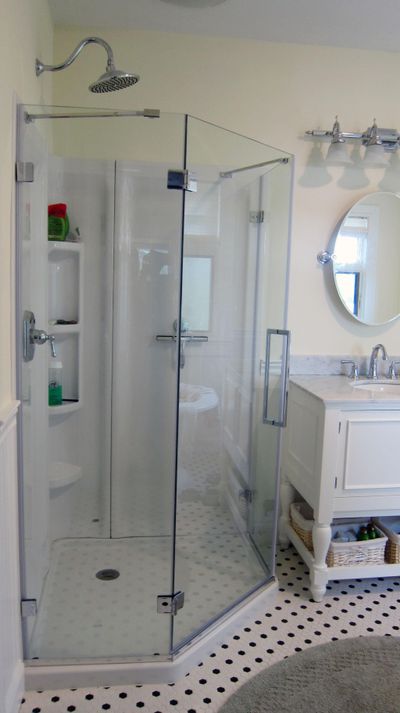Ask the Builder: Acrylic shower designs have come a long way

DEAR TIM: I’ve had it with ceramic tile in my shower. It’s hard to clean and I love the sleek look of some of the modern acrylic shower units. I want to do this job myself, so the installation needs to be DIY friendly. What’s been your experience with these easy-care shower units? Would you be kind enough to share some installation tips so I don’t goof this up? – Alice W., Xenia, Ohio
DEAR ALICE: I can hear you loud and clear about ceramic tile care. When I was younger, I seemed to have plenty of energy to wrestle with cleaning tile and grout. I did discover years ago that using powdered oxygen bleach made the job easier and less smelly, but I no longer have to deal with cleaning tile because I’ve switched out all the showers in my home to acrylic.
As you might expect, I’ve installed countless acrylic tub and shower units over the years as I’ve been a master plumber since before I was 30 years old. I’ve discovered much, to say the least. The best news is the overall quality and design of some units have come a very long way.
Years ago, acrylic shower units were often tough to install, and the design of those made for remodeling were humdrum. Just last year I installed a stunning acrylic alcove shower in my basement bathroom that was 60 inches wide and had simulated ceramic tile patterning formed into the side panels. I loved the built-in molded shelves for soap, shampoo and razors. This unit was very easy to install.
Many of the available acrylic showers today come with their own sleek shower doors that are built to fit perfectly if you follow all the instructions. I installed a frameless clear tempered glass shower door on a corner shower unit in my own master bathroom. You’d think it would be hard to work with glass panels, but it wasn’t at all.
There are big differences between acrylic shower systems in the marketplace. While they may all look the same or similar in the showroom, you need to compare the plastic materials and look behind the panels to tell the difference.
The unit I installed last year in my basement bathroom featured a proprietary solid composite material made with resins, fiberglass and filler. It’s extremely durable and is much stiffer than the acrylic material I installed more recently in my master bathroom.
My basement bath alcove shower unit didn’t require any extra wall studs because on the back of the composite fiberglass walls there were reinforcing fins that acted like miniature I-beams. Believe me, the walls are very rigid and don’t flex at all.
On the other hand, the three-piece corner acrylic shower I just installed for my wife in our master bathroom was made with a thinner acrylic that had no fins and required quite a few strategically placed wall studs to support the walls. This unit also required you to use a special tub-surround adhesive to help hold the wall panels to the studs so they don’t flex back and forth like the bottom of an old oilcan.
Here are the most important considerations when working with acrylic shower units. You can’t afford to make a mistake at any stage. Some mistakes can cost you lots of extra money if you have to buy new panels.
Before you buy a shower unit, download and carefully read the written installation instructions. Judge for yourself if you have the skills and tools required to install that particular unit. Pay close attention to the requirements for wall framing, and think about how you’ll ensure all the wall studs are where they need to be for the side nailing fins and faucet location.
Most DIYers make a grave mistake when installing the shower base. Pay extremely close attention to this part in the written instructions. Almost all units require that the base be set in some sort of wet plaster or mortar. What’s more, it’s absolutely mission critical that the shower base be perfectly level in all directions if you’re installing the factory-provided shower door kits.
The reason the bases must be set in a wet plaster is so the bottom of the shower doesn’t move when you stand in it. If the acrylic flexes at all, it will eventually crack and you’ll get leaks. I’ve discovered over the years that I get the best results using a dry-setting joint compound that sets up in 90 minutes. I mix it so it’s the consistency of warm cake icing.
The wall studs on the edges where the shower doors are to be installed must be perfectly plumb. Don’t overlook this step because you’ll pay the price when you go to install the shower door at the end of the job. You can’t grind, trim or change the size of a piece of tempered glass!
Rookies often ruin acrylic wall panels when cutting the hole for the shower faucet. The error may be based in poor measuring skills. Just remember that you can enlarge a hole but you can’t make one smaller.
I’ve found that it’s best to cut the hole with a high-speed spiral saw. This is an affordable tool that drywall installers have used for decades to cut holes in drywall for electrical boxes. The bits that come with these tools have cutting edges on the sides of the bit. You drill a small 1/4-inch hole in the acrylic panel, insert the bit, turn on the saw and slowly cut in a counterclockwise movement.
Need an answer? All of Tim’s past columns are archived for free at www.AsktheBuilder.com. You can also watch hundreds of videos, download Quick Start Guides and more, all for free.